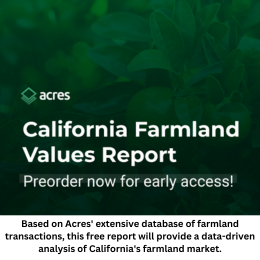December 13, 2021
By Ben Palen, Ag Management Partners LLC
The backdrop for this case study is an understanding of the past and present elements of agriculture in many of the countries in sub Saharan Africa. This region offers agricultural opportunities with scale and favorable economics, which have become more difficult to find in other parts of the world. The reasons for the latter statement include water resource issues, soil qualities, environmental issues with further development, and climate change, just to name a few. They have to do with the “maturity” of agriculture as an asset class in, say, the U.S. To be sure, there are many current and pending agtech tools that have opened the door to enhancing returns on U.S. farmland. But those gains are generally very modest, because for the most part—and again with the caveat that there are always exceptions to the rule—U.S. agriculture, and the ag sectors in other well developed countries, have already sharpened the pencil when it comes to efficiency and good returns on investment. Another way to express this is to say that the bar is high in the U.S. with respect to finding ways to make more than incremental adjustments in rates of return on farmland; that bar is very low in Africa, and therein lies the opportunity, and the challenge.
In order to provide some points of reference for the scope of agriculture on the African continent, consider the following points of reference, many of which have been gleaned from the World Bank and other international development and financial entities:
Africa is the fastest growing region in the world, with a population of 2.2 billion projected for 2050. Sub Saharan Africa could account for more than 50 percent of the world’s population growth by 2050. Africa also is the second fastest urbanizing region in the world (following Asia), and the middle class is growing rapidly. Some estimates suggest that the value of the urban food market sector will top $500 billion by 2030. Further, some 70 percent of the African population is under 30 years old.
All of the above statistics seem promising for anyone involved in agriculture. They also have to be viewed against the backdrop of a continent that, historically, has struggled just to meet its own food needs, let alone being able to export agricultural commodities. According to the Brookings Institution, and others, the cost of food imports to sub Saharan Africa exceeds the value of food exports by about $5 billion a year (most recent statistics). That said, a deeper look at the numbers suggests a more alarming issue, and that is that the primary agricultural exports are tropical commodities such as cocoa, coffee, tea, and cotton. Those tend to be high value crops, but they do not contribute in a meaningful way to human nutritional needs. The largest imported agricultural items (by value) are wheat, rice, soy, and frozen meat. The difference is clear. By and large, the ag imports are what people need to survive. And, based on discussions with some policy makers in southern Africa, the population growth and increasing middle class in most countries has created even more demand for the key commodities for human consumption, which suggests that, absent sustainable agricultural growth within the continent, the import/export imbalance is going to weaken, and probably in dramatic fashion.
The food situation must be viewed in the harsh light of the reality that according to the UN’s Intergovernmental Panel on Climate Change, 46 percent of Africa’s land suffers from degradation, and that adversely impacts near 500 million people, with a financial impact of over $9 billion annually, and social and political impacts that are seemingly incalculable.
The reasons for these startling statistics are somewhat complicated. Because the annual precipitation patterns in portions of sub Saharan Africa’s crop growing regions tend to be seasonal in nature, there can be issues with crop varieties that can tolerate the somewhat erratic rainfall events.
Second, land is often cropped intensively, and in this context that means trying to raise as many crops as possible on a given piece of land in a year, often without benefits of modern technology, or even the basics such as fertilizer and other crop protection products.
Third, farming techniques are often decades behind what is practiced in most developed areas. Rather than agricultural systems that are focused on sustainable techniques such as no-till, cover crops, variable rate technology, and water saving irrigation methods, the normal methods just add to the continued degradation of the land.
Fourth, there are challenges for many farmers in having sufficient capital to get the inputs that they need to do things in a timely manner. That is in direct contrast to, say, U.S. farmers, who have ample sources of capital, both short-term and long-term, readily available.
By some estimates, if the above trends continue, about 50 percent of the currently farmed areas in Africa will become unsuitable for continued cropping. In addition to the above-noted items, there is the looming factor of climate change. As with most regions of the world, Africa has been, and will continue to be, impacted by climate change, notably an increase in temperatures, and a reduction in precipitation.
It is against this backdrop of challenges that a Zimbabwean-based company called Dendairy has formulated plans for a large-scale (12,500 acres) irrigation development project in the semi-arid part of that nation. This would be a significant expansion from the company’s current irrigated acreage of about 2,000.
The next part of this case study will be a multi-faceted look into the heart of the large project, and we will address economic, political, social, and agronomic factors.
Any discussion of African agriculture would be incomplete without mentioning the political climate on the continent. It has not exactly been a poster child for stability. There are, however, signs of change as the reality of the topics noted above become front and center for governments at all levels.
ABOUT THE AUTHOR:
Ben Palen is a fifth generation farmer with experience in many aspects of agriculture, including projects in the United States, Africa, and the Middle East. The focus on all projects is sustainable practices based on a mix of boots on the ground work and selected use of agtech tools.
** All views, data, opinions and declarations expressed are solely those of the author(s) and not of Global AgInvesting, GAI News, or parent company HighQuest Group.

Let GAI News inform your engagement in the agriculture sector.
GAI News provides crucial and timely news and insight to help you stay ahead of critical agricultural trends through free delivery of two weekly newsletters, Ag Investing Weekly and AgTech Intel.




